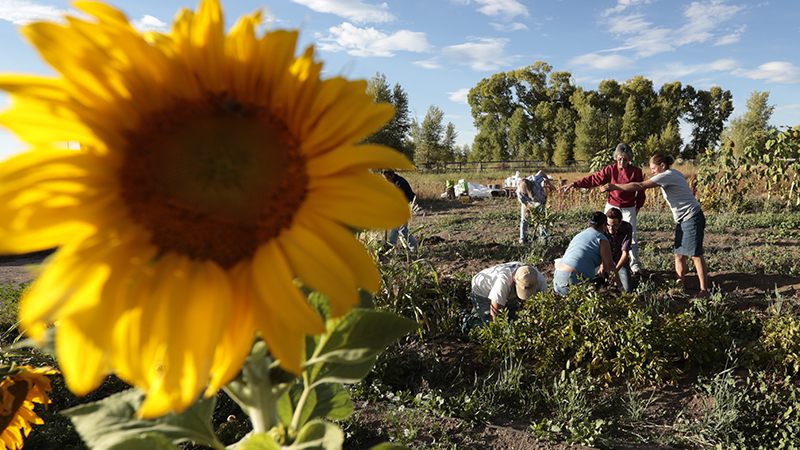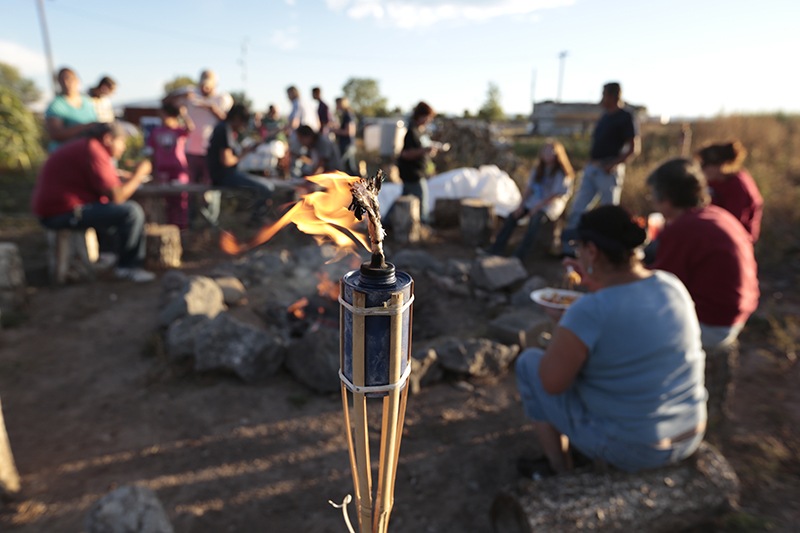Community Voices: Creating a Better Story for Antonito
Leer en español
Community gardeners gather a harvest in Antonito in fall 2015. Photos by Joe Mahoney
By Pauline Victoria Martinez
The Colorado Trust has teamed with rural community members across Colorado who are helping facilitate conversations with neighbors about what they love about their communities, and what’s difficult about them. Pauline Victoria Martinez lives in Conejos County, and is working as a research consultant for communities in the San Luis Valley. She writes here about the town of Antonito.
Everyone has a story about their families, their identities and the things that have happened to them. Just as people have stories, so do towns. Residents in the small rural town of Antonito, who have been unhappy with the story that others have told about their town, are working hard to create a better one.
Antonito serves as the southern gate to the San Luis Valley and is the first town that greets visitors coming north on U.S. Route 285 from New Mexico into Colorado. The story of Antonito starts at its founding in the 1800s when the town and the land surrounding it were part of the Conejos Land Grant. The land was given to the people by Mexico to use communally for livestock farming and grazing, gathering firewood and herbs, and recreation.

The problems started after the Mexican-American War, when the United States took over the territory from Mexico. In 1948, the U.S. government signed the Treaty of Guadalupe Hidalgo, in which it promised to honor the land grants. However, that promise wasn’t kept; the land was eventually usurped from the people.
According to some research, land loss such as this can lead to language and identity loss that may result in generational poverty and drug abuse. The loss of the Conejos Land Grant was just the start of many inequities Antonito would suffer.
Many Hispanic farmers and ranchers in the region say they faced discrimination at the hands of the U.S. Department of Agriculture (USDA), leaving them unable to access much-needed funds in order to sustain their farms. A lawsuit was filed, known as Garcia v. Vilsack, but the lawsuit was not recognized as a class action. The USDA, however, admitted to discriminatory actions within their offices, and subsequently initiated a claims resolution process. This allowed Hispanic farmers and ranchers to claim compensation for lost income, land, livestock and having to scale down their farming and ranching operations. Some Antonito farmers and ranchers took part in this process; a few of them have been awarded settlements and are now waiting to be compensated, according to my research.
The town also found itself facing off with yet another governmental entity, this time the U.S. Department of Transportation’s Surface Transportation Board. Former Mayor Mike Trujillo, current Mayor Aaron Abeyta and other members of Conejos Clean Water, Inc. helped the town fight a battle to keep radioactive waste from being transferred near their community from truck to rail, and then transported directly through their community from Los Alamos National Laboratory in New Mexico. In talking about how the waste management and railroad corporations viewed their community, Abeyta told me: “They see these things and therefore they view our poverty as weakness. They see our fallen things and imagine it must mean complacency and apathy. Put a different way, they believe we won’t fight back.” The people of Antonito did fight back, and won.
It is because of struggles like these that the people of Antonito have come together as one, bonded by loyalty and pride. This community connection is the driving force for residents of Antonito when they speak proudly of their small community and its heritage.
One site of cultural pride is the building that once housed La Sociedad Proteccion Mutua de Trabajadores Unidos (The Society for the Mutual Protection of United Workers). This organization was founded in 1900 to help protect and benefit small farming communities in southern Colorado; the principal founder, Celedonio Mondragon, is recognized by people here as a hero. Over the years, the society provided burial services, insurance and helped unite the working class against discrimination. The preamble of the society’s constitution sets out its objective: “To protect each other against the injustices of tyrants and despots, the usurpers of law and justice, and those who steal our lives, honor, and property.”
Another historic site that has many stories all its own—and was recently in the news—is the oldest church in Colorado, Our Lady of Guadalupe Parish. Many visitors from around the country travel to the southern tip of Colorado to see its two majestic steeples reaching toward the sky and admire the old stained glass windows. I suggest visiting the old church in the morning when the sunrise makes the colors in the stained glass come alive and dance along the church walls.
In addition to the church, the town also hosts one of the few narrow gauge railroads still in active use, the Cumbres and Toltec Scenic Railroad. In 1969, the railroad was abandoned for lack of use, but thanks to some resourceful railroad preservationists and local civic interests, the most scenic section of the railroad was saved. In 1970, a joint effort between the states of Colorado and New Mexico put the railroad back in use, taking tourists between the towns of Antonito and Chama, New Mexico. In 2012, the Cumbres was designated a National Historic Landmark.
Residents also boast about attractions such as the folk art home of a local resident known as Cano’s Castle, which draws many visitors to Antonito. Other attractions include the amazing fishing along the Conejos River, a local elk farm and the Los Caminos Antiguos Scenic Byway.
A deep sense of connection to the town’s beauty, culture, heritage and history has prompted a group of active residents to meet regularly in order to discuss the future of the town. With the assistance of The Colorado Trust, the group has put together a three-year plan to make Antonito an even healthier and happier place to live. The group has chosen to focus on three specific areas: the local economy, recreation, and leadership and cultural advocacy.
Jay Warner, who has participated in the resident group since its inception, said it has been important for the group to “grow the future from the roots of the past.” The stories of the past are important and should be preserved and passed on to future generations; understanding history is also integral in creating a better story for the future.
“We stand strong together,” said Alice Candy, another group participant. The experience of creating the three-year plan has formed an even stronger bond among the resident team. It has also sparked interest from other residents who are eager to join in the efforts.
Read more by Pauline Victoria Martinez at her blog, Rethinking Rural Women.